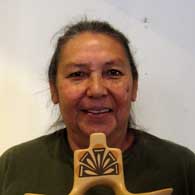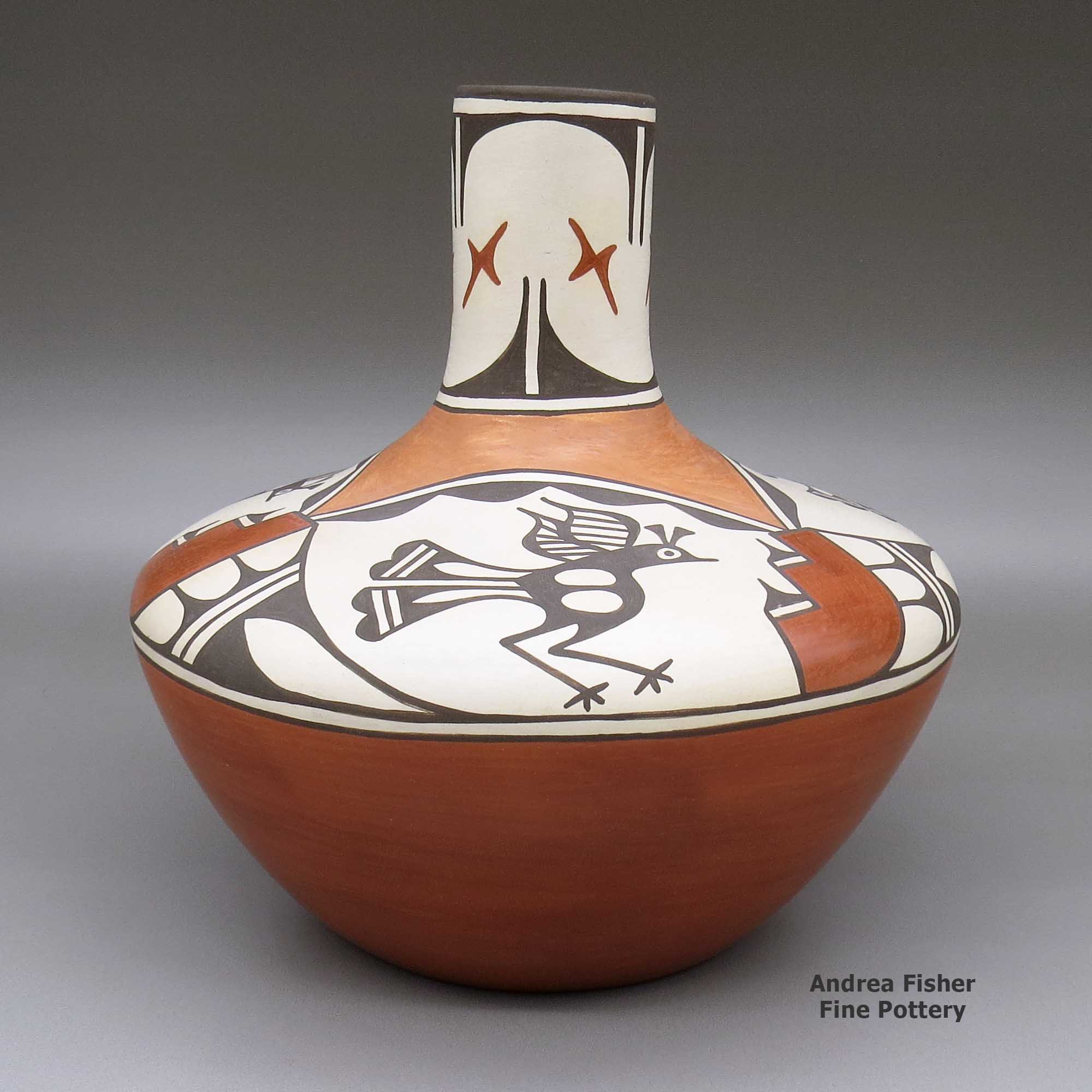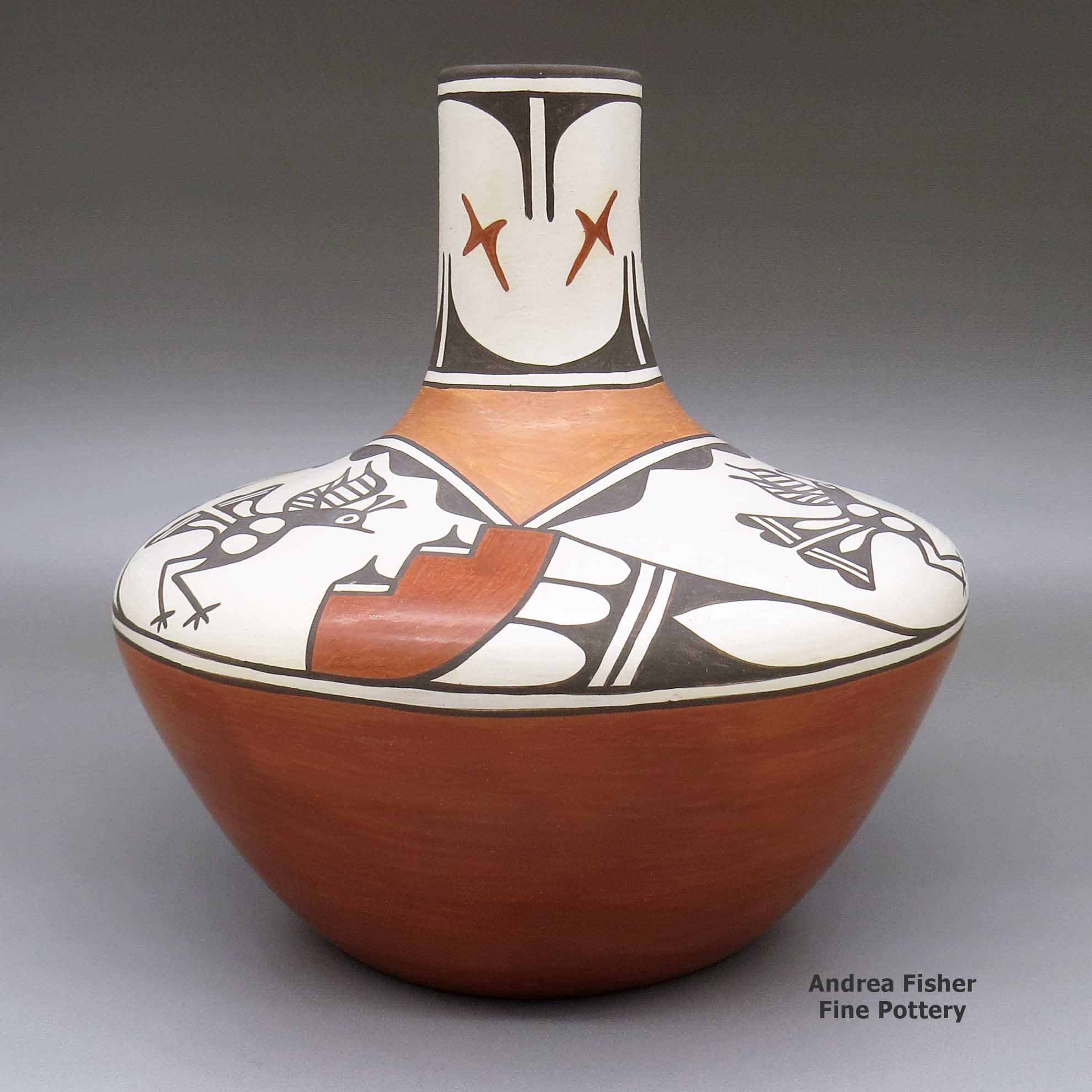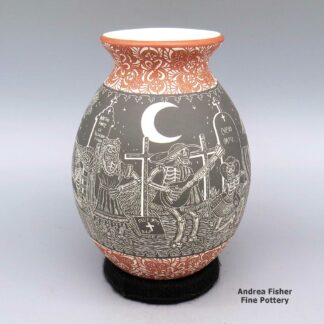| Dimensions | 10.5 × 10.5 × 11.25 in |
|---|---|
| Condition of Piece | Very good, normal wear |
| Signature | Ruby Panana Zia |
| Date Born | 2023 |
Ruby Panana, zzza3b573, Jar with 3-panel Zia design
$1,200.00
A polychrome jar with a tall neck and decorated with a traditional Zia three-panel roadrunner and geometric design
In stock
Brand
Panana, Ruby
 The daughter of Seferina Bell, Ruby Panana was born into Zia Pueblo in the early 1950s. She grew up watching her famous mother making pottery but she told us she didn't begin herself until she was almost 30 years old.
The daughter of Seferina Bell, Ruby Panana was born into Zia Pueblo in the early 1950s. She grew up watching her famous mother making pottery but she told us she didn't begin herself until she was almost 30 years old.After Ruby finished high school at Albuquerque's West Mesa High, she went on to the University of New Mexico in search of a teaching degree. However, her scholarships didn't cover all that she needed covered and it wasn't long before she returned to Zia Pueblo.
Then she met and married her husband and moved to his home at Jemez Pueblo. As much as Ruby now lives at Jemez Pueblo, she still makes her pottery in the Zia style she learned from her mother.
In addition to her famous mother Ruby counts potters Kathy Pino and Eleanor Pino Griego among her close family.
Since immersing herself full time in her pottery making, she has blazed a trail for other Zia potters. Ruby participates in shows at the Walatowa Visitor Center, the Heard Museum Guild Indian Fair and Market in Phoenix, the Santa Fe Indian Market, the Southwest Indian Art Fair in Tucson and the Eight Northern Pueblos Arts and Crafts Fair in Espanola, NM.
Ruby has earned ribbons for Best of Show from Walatowa, First and Second Place at Santa Fe Indian Market, Best of Pottery at the Heard, First and 2Second Place at Eight Northern Pueblos and the Purchase Award at Tucson (meaning: the Arizona State Museum bought the pot she submitted to be judged).
Ruby tells us her favorite shapes to work with are water jars. Her favorite designs to paint include roadrunners and rainbows.
Like many Native American potters, Ruby says she gets her inspiration from the clay itself. That's part of what causes her to enjoy making pottery so much.
When she's not making pottery you might find Ruby near a basketball game. Her favorite team is the UConn Women's Basketball Team. She also enjoys regular visits to the casino (although she doesn't ever win much) and she's lately gotten into a business buying abandoned storage units...
A Short History of Zia Pueblo

Zia Pueblo is situated in the Jemez Mountains with Jemez Pueblo to the north and Santa Ana Pueblo to the south. Despite its picture postcard setting, Zia's history for the last four hundred years has been difficult.
Antonio de Espejo led a small troop of Spanish explorers up the Jemez River and discovered Zia Pueblo in 1583. Espejo estimated there were about 4,000 inhabitants in a city of house blocks up to three and four stories high with five major plazas and many smaller ones. "The people are clean. The women wear a blanket over their shoulders tied with a sash at their waist - their hair cut in front, and the rest plaited so that it forms two braids, and above a blanket of turkey feathers," is how Espejo's scribe recorded it.
The people of Zia participated in the Pueblo Revolt of 1680 and when Spanish troops returned in 1682 and 1687, the Zias were able to repulse them. When more Spanish troops returned in 1688 they were finally successful in conquering the Zias. The Spanish killed many people, burned the pueblo and took many slaves back to Mexico with them.
When Don Diego de Vargas returned to northern Nuevo Mexico in 1692, the Zias sued for peace and accepted the rule of Spain almost immediately. In the revolt of 1696 the Zia, Santa Ana and San Felipe remained loyal to the Spaniards. In another revolt in 1728-9, Zia joined with Jemez, Santa Ana and Cochiti against the Spaniards and when things turned against them, they all fled to various mountain refuges while the Spaniards again burned everything they left behind.
The new Spanish government did little to protect the pueblos from the raids of nomadic Ute, Apache, Comanche and Navajo warriors. Nor did the government of Mexico after it declared independence from Spain in 1820 nor did the government of the United States after it acquired Zia in 1848. Zia fortunes slid in many ways and by the 1890s the tribe was down to just 98 members.
Today, the Pueblo of Zia numbers about 800 people, many of whom are active artists producing everything from pottery to jewelry to baskets to paintings, sculptures and wood carvings.

For more info:
Pueblos of the Rio Grande, Daniel Gibson, ISBN-13:978-1-887896-26-9, Rio Nuevo Publishers, 2001
Photo courtesy of Jared Tarbell, Creative Commons Attribution 2.0 Generic License
About Jars
The jar is a basic utilitarian shape, a container generally for cooking food, storing grain or for carrying and storing water. The jar's outer surface is a canvas where potters have been expressing their religious visions and stories for centuries.
In Sinagua pueblos (in northern Arizona), the people made very large jars and buried them up to their openings in the floors of the hidden-most rooms in their pueblo. They kept those jars filled with water but also kept smaller jars of meat and other perishables inside those jars in the water. It's a form of refrigeration still in use among indigenous people around the world.
Where bowls tend to be low, wide and with large openings, jars tend to be more globular: taller, less wide and with smaller openings.
For a potter looking at decorating her piece, bowls are often decorated inside and out while most jars are decorated only on the outside. Jars have a natural continuity to their design surface where bowls have a natural break at the rim, effectively yielding two design surfaces on which separate or complimentary stories can be told.
Before the mid-1800s, storage jars tended to be quite large. Cooking jars and water jars varied in size depending on how many people they were designed to serve. Then came American traders with enameled metal cookware, ceramic dishes and metal eating utensils...Some pueblos embraced those traders immediately while others took several generations to let them and their innovations in. Either way, opening those doors led to the virtual collapse of utilitarian pottery-making in most pueblos by the early 1900s.
In the 1920s there was a marked shift away from the machinations of individual traders and more toward marketing Native American pottery as an artform. Maria Martinez was becoming known through her exhibitions at various major industrial fairs around the country and Nampeyo of Hano was demonstrating her art for the Fred Harvey Company at the Grand Canyon. The first few years of the Santa Fe Indian Market helped to solidify that movement and propel it forward. It took another couple generations of artists to open other venues for their art across the country and turn Native American art into the phenomenon it has become.
Today's jars are artwork, not at all for utilitarian purposes, and their shapes, sizes and decorations have evolved to reflect that shift.
Traditional Zia Design
On typical Zia Pueblo jars, the traditional Zia design pattern consists of three primary colors: mineral red and beeweed black on a slipped yellow-beige background. Traditionally, the base of the piece is well-slipped with red (the Earth band). There is often a red or black band around the rim (the sky band). In between, on the yellow-beige background, red and/or black images and symbols are painted in designs around the body.
The traditional design around the body consists of a flowing red ribbon, alternating up and down to make four panels around the piece. That's the rainbow which flows around at least two traditional roadrunner figures holding sprigs of yucca flowers in their claws. Sometimes there are two roadrunners below and two above that ribbon.
Rising from the Earth band, hanging from the sky band and attached to the rainbow ribbon are usually symbols evocative of clouds, rainfall and healthy cornfields. Those symbols can be sprinkled liberally around a pot, too.
Ascencion Galvan Pino Family Tree - Zia Pueblo
Disclaimer: This "family tree" is a best effort on our part to determine who the potters are in this family and arrange them in a generational order. The general information available is questionable so we have tried to show each of these diagrams to living members of each family to get their input and approval, too. This diagram is subject to change should we get better info.
- Rufina Galvan (c. 1882-) & Celestino Galvan
- Ascencion Galvan Pino (c. 1900-) and Joe Pino
- Seferina Bell (1920-1986)
- Ruby Panana (1954-)
- Katherine Pino (c. 1935-2017)
Her student:
- Veronica Pino Baca (1934-)
- Laura Pino (c. 1930s-)
- Eleanor Pino Griego (1953-)
- Daniel Sebastien Griego
- Angel Griego
- Star Griego
- Daniel Sebastien Griego
- Reyes Pino (c. 1950's-)
- Eleanor Pino Griego (1953-)
- Tomasita Pino (c. 1930s-)
- Seferina Bell (1920-1986)






